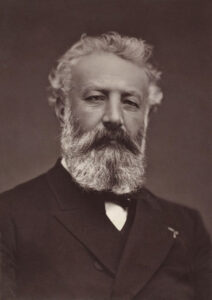
A Journey to the Centre of the Earth
The story begins in May 1863 at the home of Professor Otto Lidenbrock in Hamburg, Germany. While leafing through an original runic manuscript of an Icelandic saga, Lidenbrock and his nephew Axel find a coded note written in runic script along with the name of a 16th-century Icelandic alchemist, Arne Saknussemm. When translated into English, the note reads: Go down into the crater of Snaefells Jökull, which Scartaris’s shadow caresses just before the calends of July, O daring traveller, and you’ll make it to the earth’s centre. I’ve done so. Lidenbrock departs for Iceland immediately, taking the reluctant Axel with him. After a swift trip via Kiel and Copenhagen, they arrive in Reykjavík. They hire as their guide Icelander Hans Bjelke, a Danish-speaking eider-duck hunter, and then travel overland to the base of Snæfellsjökull.
They reach the volcano in late June and set off into the earth’s bowels, encountering many dangers and strange phenomena. After taking a wrong turn, they run short of water, and Axel nearly perishes, but Hans saves them all by tapping into an underground river, which shoots out a stream of water that Lidenbrock and Axel name the “Hansbach” in the guide’s honour. Édouard Riou’s illustration of an ichthyosaurus (more like a mosasaurus) battling a plesiosaurus. Following the course of the Hansbach, the explorers descend many miles and reach an underground world with an ocean, a vast ceiling with clouds, and a permanent Aurora giving light. The travellers build a raft out of semi-petrified wood and set sail. At the same time, at sea, they encounter prehistoric fish such as Pterichthyodes (here called “Pterichthys”), Dipterus (referred to as “Dipterides”), and giant marine reptiles from the Age of the Dinosaurs, namely an Ichthyosaurus and a Plesiosaurus.
A lightning storm threatens to destroy the raft and its passengers. Instead, it throws them onto the site of an enormous fossil graveyard, including bones from the Pterodactylus, Megatherium, Deinotherium, Glyptodon, a mastodon, and the preserved body of a prehistoric man. Lidenbrock and Axel venture into a forest featuring primitive vegetation from the Tertiary Period; in its depths, they are stunned to find a prehistoric humanoid more than twelve feet in height and watching over a herd of mastodons. Fearing they may be hostile, they leave the forest.
Read or download Book
Jules Verne
Jules Gabriel Verne 8 February 1828 – 2 4 March 1905 was a French novelist, poet, and playwright.
Biography
His collaboration with the publisher Pierre-Jules Hetzel led to the creation of the Voyages Extraordinaires, a series of bestselling adventure novels including Journey to the Center of the Earth (1864), Twenty Thousand Leagues Under the Seas (1870), and Around the World in Eighty Days (1872). His novels, always well documented, are generally set in the second half of the 19th century, considering the technological advances of the time. In addition to his novels, he wrote numerous plays, short stories, autobiographical accounts, poetry, songs, and scientific, artistic, and literary studies.
His work has been adapted for film and television since the beginning of cinema and for comic books, theatre, opera, music, and video games. Verne is considered an essential author in France and most of Europe, where he has greatly influenced the literary avant-garde and surrealism. His reputation was markedly different in the Anglosphere, where he had often been labelled a writer of genre fiction or children’s books, mainly because of the highly abridged and altered translations in which his novels usually were printed. Since the 1980s, his literary reputation has improved. Jules Verne has been the second most-translated author in the world since 1979, ranking below Agatha Christie and above William Shakespeare. He has sometimes been called the “father of science fiction”, a title that has also been given to H. G. Wells and Hugo Gernsback. In the 2010s, he was the most translated French author in the world. In France, 2005 was declared “Jules Verne Year” on the occasion of the centenary of the writer’s death.






